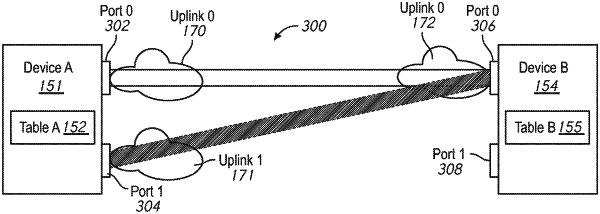| CPC H04W 76/12 (2018.02) [H04L 61/256 (2013.01); H04L 61/2592 (2013.01); H04L 63/029 (2013.01); H04L 63/0272 (2013.01); H04W 76/11 (2018.02); H04L 61/2514 (2013.01); H04L 61/2517 (2013.01)] | 30 Claims |

|
1. A method, comprising:
at a first network device corresponding to a first network site, including a memory, a non-transitory computer readable storage medium, one or more processors and two or more communication ports:
communicating with one or more remote hosts to obtain, at the first network device, contact point information for a second network site, the second network site comprising one or more other network devices associated with the first network device as peer devices in a private network,
wherein the contact point information for the second network site includes one or more peer uplink identifiers, each respective peer uplink identifier corresponding to a respective peer device uplink of a corresponding one of the one or more other network devices;
establishing a first private network data tunnel from a first uplink of the first network device to the second network site, based on the contact point information including a first uplink identifier associated with a first peer device uplink, the first uplink of the first network device is associated with a first set of source and destination ports connected to one or more first networks;
establishing a second private network data tunnel from a second uplink of the first network device to the second network site, based on the contact point information including a second uplink identifier associated with a second peer device uplink, the second uplink of the first network device is associated with a second set of source and destination ports connected to one or more second networks,
wherein the first and second private network data tunnels are concurrently active for sending data, and
wherein the first private network data tunnel is associated with a first link type and the second private network data tunnel is associated with a second link type,
wherein the first link type is at least one of a public network connection, an Internet link, or an internet service provider connection, wherein the second link type is at least one of a Multiprotocol Label Switching (MPLS) link or a wireless link; and
selectively routing data from the first network device to the second network site across the first private network data tunnel and the second private network data tunnel.
|